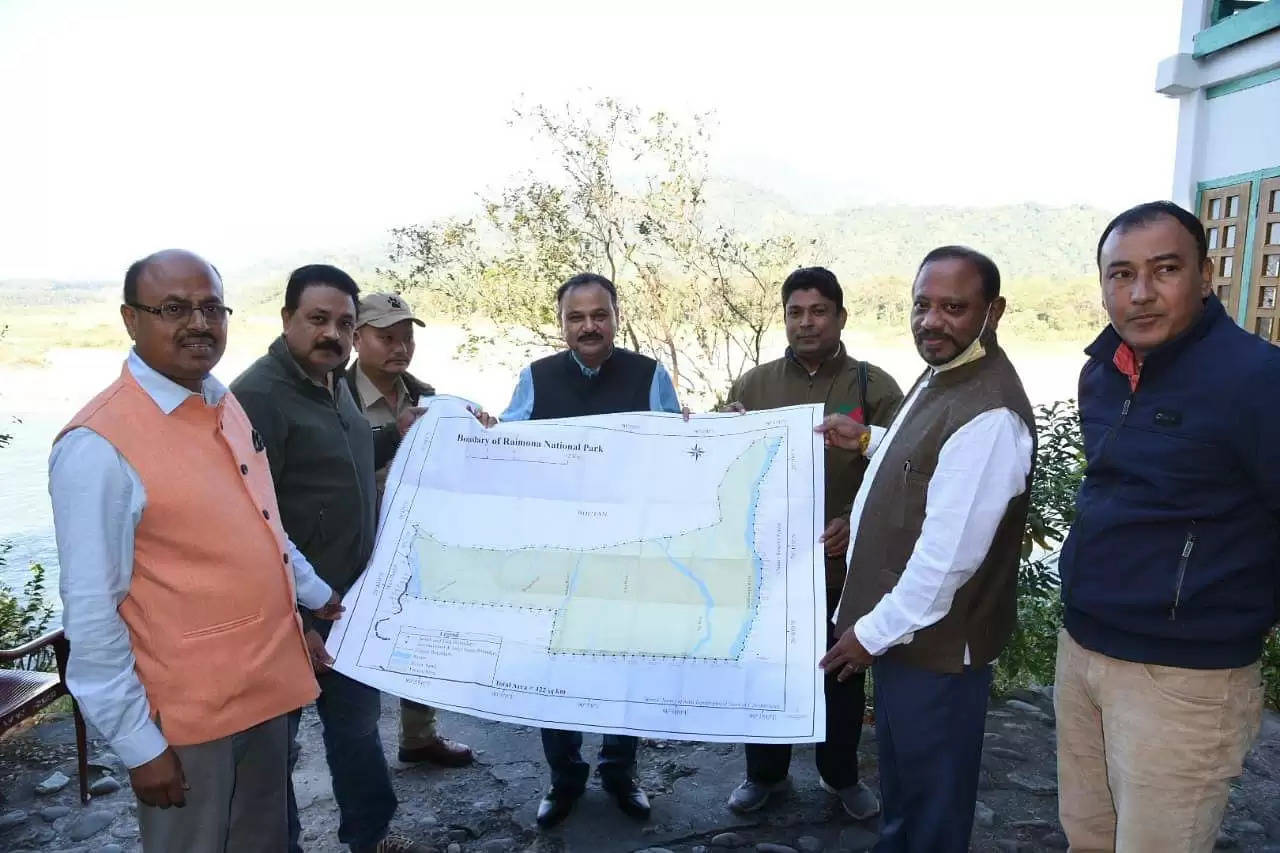Assam to get sixth national park; minister unveils map

GUWAHATI: (Updated)
Assam is gearing up to have its sixth national park, state forest and environment minister Parimal Suklabaidya informed.
The map of the proposed “Raimona National Park” was unveiled by the minister at Mathanguri in Manas National Park on Saturday.
“Another success feather is adding to the biodiversity cap of Assam soon as we have initiated the process for approving the proposal for the 6th National Park of Assam, the ‘Raimona National Park’. Today unveiled the map of this upcoming park at Mathanguri, Manas National Park,”, Suklabaidya posted on Twitter.
ALSO READ:
Also Read: IIT Guwahati & IIT(BHU) to start joint doctoral programme
According to official sources, a proposal has been submitted to the Assam Governor for upgrading an area of 422 sq km of the notified Ripu Reserve Forest under Manas National Park and Tiger Reserve as the proposed “Raimona National Park.”
Reports state that a substantial area of Ripu Reserve Forest has been encroached upon because of insurgency-related issues since three decades back.
Assam currently has five national parks - Kaziranga National Park, Manas National Park, Dibru-Saikhowa National Park, Orang National Park and Nameri National Park.
ALSO WATCH:
Troubled past
Reports state that individuals have encroached onto a substantial area of the reserve forest because of insurgency-related issues over the past three decades.
The forest and its denizens were ruthlessly massacred. Almost all forest establishments were gutted with the destruction of wildlife from the late eighties when the ethnopolitical movement turned into a violent armed struggle in the landscape.
As a result, the compact forest belt had been critically fragmented.
Diverse species
Historically, the proposed area was a part of the migratory route of the faunal species from Himalayan Mountain, Indo-Malayan and Indo-Chinese realms towards the west and Peninsular Indian realm species to the east.
The area of the proposed Raimona NP lies within one of the oldest Reserved Forest (Ripu RF) of the state, with a history of one of the best scientifically managed forests in the country during the late 19th century.
The area comprises the highest biodiverse florist composition of the state, wherein one could classify eleven different forest types and subtypes.
This proposed National Park shares contiguous forest patches of Phipsoo Wildlife Sanctuary and Jigme Singye Wangchuk National Park in Bhutan (total area of 1,999 km2) creating a trans-boundary conservation landscape of over 2,400 sq km. Such secured trans-boundary ecological landscape will ensure the long-term conservation of endemic species like Golden Langur or Trachypithecus geei (the mascot of BTC) and endangered species like the Asian Elephant, Royal Bengal Tiger and other species of flora and fauna.
High potential
If this proposed area within the Ripu Reserve Forest is upgraded to a National Park, Manas Tiger Reserve would become a highly potential forest block for long-term conservation of both flora and fauna of the state.
With this upgrade, Manas TR would comprise three core areas as well for the source population to breed.
Besides this, the proposed Raimona National Park will be contiguous with the Buxa TR of West Bengal on the west, Phipsoo Wildlife Sanctuary and Jigme Singye Wangchuk National Park of Bhutan on the northern side and vast forest areas of Chirang RF on its eastern side forming a highly physically viable conservation unit.
The proposed National Park will open up a tremendous opportunity of ecotourism for the fringe villagers, who currently are partially or dependent on forest resources for their livelihood.
Tourism circuit
A highly viable tourism circuit through proposed Raimona NP and the contiguous protected areas of Bhutan will attract national and international tourists.
Apart from the wildlife and outstanding scenic beauty, tourists would also enjoy the diverse and colourful social landscapes and their rich culture and tradition.
It is sure that once the proposed area of Ripu RF is upgraded to a national park, there would be a rush of tourists which would pave the way for the local people for various income generating avenues.
Government area
As per the notified Ripu Reserve Forest, the proposed area is free from the legal obligation of a right of any kind. Hence the proposed NP’s land area is vested to the state government.
Such status of the land is adequate to declare the area a National Park as per Section 35 (4) (b) of the Wildlife (Protection) Act, 1972 (as amended up to 2006) by the State Government.
Wildlife Trust of India (WTI), a national level organisation that commits to secure the natural heritage of India, has also assisted in the process to come up with the state’s sixth national park.
WTI has been working in Manas landscape over the past 15 years to bring the old heritage back of Manas closely with the Assam Forest Department, Bodoland Territorial Council and local communities.
Historical background
In ancient times, the proposed Raimona National Park was under thinly populated human habitation.
According to reports, the area was an estate named Ripudwar with capital at ‘Raymana’ (Raimona). The estate was controlled by a Suba (Bhutan governor) appointed by the Deva Raja (administrative king) of Bhutan. He collected tributes from the subjects in favour of Dev Raja.
Ripudwar was one of the eighteen such dwars (passes) that existed on the foothills of Bhutan. The Suba had not alone realised taxes, but also settled the disputes of the estate.
Reports often cited that Bhutan tax collectors raided the estate and terrorised the subjects to keep them panic-stricken to subjugate them easily. Similar was the conditions in Chirang, Sidli and other such estates.
(Edited by Ibankyntiew Mawrie)

















